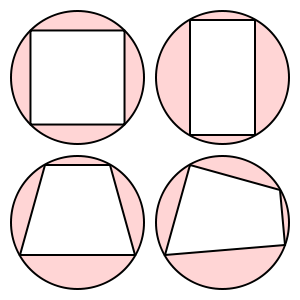Circumscribed circle
In geometry, the circumscribed circle or circumcircle of a polygon is a circle that passes through all the vertices of the polygon. The center of this circle is called the circumcenter and its radius is called the circumradius.
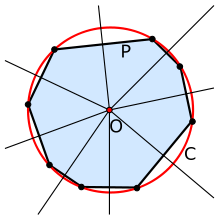
Not every polygon has a circumscribed circle. A polygon that does have one is called a cyclic polygon, or sometimes a concyclic polygon because its vertices are concyclic. All triangles, all regular simple polygons, all rectangles, all isosceles trapezoids, and all right kites are cyclic.
A related notion is the one of a minimum bounding circle, which is the smallest circle that completely contains the polygon within it, if the circle's center is within the polygon. Every polygon has a unique minimum bounding circle, which may be constructed by a linear time algorithm. Even if a polygon has a circumscribed circle, it may be different from its minimum bounding circle. For example, for an obtuse triangle, the minimum bounding circle has the longest side as diameter and does not pass through the opposite vertex.
Triangles
All triangles are cyclic; that is, every triangle has a circumscribed circle.
Straightedge and compass construction
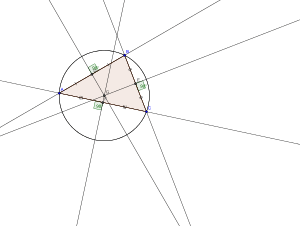
The circumcenter of a triangle can be constructed by drawing any two of the three perpendicular bisectors. For three non-collinear points, these two lines cannot be parallel, and the circumcenter is the point where they cross. Any point on the bisector is equidistant from the two points that it bisects, from which it follows that this point, on both bisectors, is equidistant from all three triangle vertices. The circumradius is the distance from it to any of the three vertices.
Alternate construction
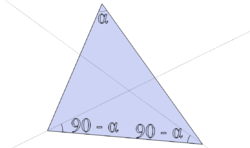
An alternate method to determine the circumcenter is to draw any two lines each one departing from one of the vertices at an angle with the common side, the common angle of departure being 90° minus the angle of the opposite vertex. (In the case of the opposite angle being obtuse, drawing a line at a negative angle means going outside the triangle.)
In coastal navigation, a triangle's circumcircle is sometimes used as a way of obtaining a position line using a sextant when no compass is available. The horizontal angle between two landmarks defines the circumcircle upon which the observer lies.
Circumcircle equations
Cartesian coordinates
In the Euclidean plane, it is possible to give explicitly an equation of the circumcircle in terms of the Cartesian coordinates of the vertices of the inscribed triangle. Suppose that
are the coordinates of points A, B, and C. The circumcircle is then the locus of points v = (vx,vy) in the Cartesian plane satisfying the equations
guaranteeing that the points A, B, C, and v are all the same distance r from the common center u of the circle. Using the polarization identity, these equations reduce to the condition that the matrix
has a nonzero kernel. Thus the circumcircle may alternatively be described as the locus of zeros of the determinant of this matrix:
Using cofactor expansion, let
we then have a|v|2 − 2Sv − b = 0 and, assuming the three points were not in a line (otherwise the circumcircle is that line that can also be seen as a generalized circle with S at infinity), |v − S/a|2 = b/a + |S|2/a2, giving the circumcenter S/a and the circumradius √b/a + |S|2/a2. A similar approach allows one to deduce the equation of the circumsphere of a tetrahedron.
Parametric equation
A unit vector perpendicular to the plane containing the circle is given by
Hence, given the radius, r, center, Pc, a point on the circle, P0 and a unit normal of the plane containing the circle, , one parametric equation of the circle starting from the point P0 and proceeding in a positively oriented (i.e., right-handed) sense about is the following:
Trilinear and barycentric coordinates
An equation for the circumcircle in trilinear coordinates x : y : z is[1]:p. 199 a/x + b/y + c/z = 0. An equation for the circumcircle in barycentric coordinates x : y : z is a2/x + b2/y + c2/z = 0.
The isogonal conjugate of the circumcircle is the line at infinity, given in trilinear coordinates by ax + by + cz = 0 and in barycentric coordinates by x + y + z = 0.
Higher dimensions
Additionally, the circumcircle of a triangle embedded in d dimensions can be found using a generalized method. Let A, B, and C be d-dimensional points, which form the vertices of a triangle. We start by transposing the system to place C at the origin:
The circumradius, r, is then
where θ is the interior angle between a and b. The circumcenter, p0, is given by
This formula only works in three dimensions as the cross product is not defined in other dimensions, but it can be generalized to the other dimensions by replacing the cross products with following identities:
Circumcenter coordinates
Cartesian coordinates
The Cartesian coordinates of the circumcenter are
with
Without loss of generality this can be expressed in a simplified form after translation of the vertex A to the origin of the Cartesian coordinate systems, i.e., when A′ = A − A = (A′x,A′y) = (0,0). In this case, the coordinates of the vertices B′ = B − A and C′ = C − A represent the vectors from vertex A′ to these vertices. Observe that this trivial translation is possible for all triangles and the circumcenter of the triangle A′B′C′ follow as
with
Due to the translation of vertex A to the origin, the circumradius r can be computed as
and the actual circumcenter of ABC follows as
Trilinear coordinates
The circumcenter has trilinear coordinates[1]:p.19
- cos α : cos β : cos γ
where α, β, γ are the angles of the triangle.
In terms of the side lengths a, b, c, the trilinears are[2]
Barycentric coordinates
The circumcenter has barycentric coordinates
where a, b, c are edge lengths (BC, CA, AB respectively) of the triangle.
In terms of the triangle's angles the barycentric coordinates of the circumcenter are[2]
Circumcenter vector
Since the Cartesian coordinates of any point are a weighted average of those of the vertices, with the weights being the point's barycentric coordinates normalized to sum to unity, the circumcenter vector can be written as
Here U is the vector of the circumcenter and A, B, C are the vertex vectors. The divisor here equals 16S 2 where S is the area of the triangle. As stated previously
Cartesian coordinates from cross- and dot-products
In Euclidean space, there is a unique circle passing through any given three non-collinear points P1, P2, and P3. Using Cartesian coordinates to represent these points as spatial vectors, it is possible to use the dot product and cross product to calculate the radius and center of the circle. Let
Then the radius of the circle is given by
The center of the circle is given by the linear combination
where
Location relative to the triangle
The circumcenter's position depends on the type of triangle:
- If and only if a triangle is acute (all angles smaller than a right angle), the circumcenter lies inside the triangle.
- If and only if it is obtuse (has one angle bigger than a right angle), the circumcenter lies outside the triangle.
- If and only if it is a right triangle, the circumcenter lies at the center of the hypotenuse. This is one form of Thales' theorem.
_Circumscribed.svg.png) The circumcenter of an acute triangle is inside the triangle
The circumcenter of an acute triangle is inside the triangle_Circumscribed.svg.png) The circumcenter of a right triangle is at the center of the hypotenuse
The circumcenter of a right triangle is at the center of the hypotenuse_Circumscribed.svg.png) The circumcenter of an obtuse triangle is outside the triangle
The circumcenter of an obtuse triangle is outside the triangle
These locational features can be seen by considering the trilinear or barycentric coordinates given above for the circumcenter: all three coordinates are positive for any interior point, at least one coordinate is negative for any exterior point, and one coordinate is zero and two are positive for a non-vertex point on a side of the triangle.
Angles
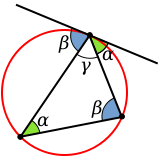 |
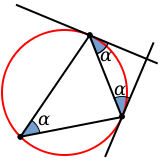 |
The angles which the circumscribed circle forms with the sides of the triangle coincide with angles at which sides meet each other. The side opposite angle α meets the circle twice: once at each end; in each case at angle α (similarly for the other two angles). This is due to the alternate segment theorem, which states that the angle between the tangent and chord equals the angle in the alternate segment.
Triangle centers on the circumcircle of triangle ABC
In this section, the vertex angles are labeled A, B, C and all coordinates are trilinear coordinates:
- Steiner point = bc / (b2 − c2) : ca / (c2 − a2) : ab / (a2 − b2) = the nonvertex point of intersection of the circumcircle with the Steiner ellipse. (The Steiner ellipse, with center = centroid (ABC), is the ellipse of least area that passes through A, B, and C. An equation for this ellipse is 1/(ax) + 1/(by) + 1/(cz) = 0.)
- Tarry point = sec (A + ω) : sec (B + ω) : sec (C + ω) = antipode of the Steiner point
- Focus of the Kiepert parabola = csc (B − C) : csc (C − A) : csc (A − B).
Other properties
The diameter of the circumcircle, called the circumdiameter and equal to twice the circumradius, can be computed as the length of any side of the triangle divided by the sine of the opposite angle:
As a consequence of the law of sines, it does not matter which side and opposite angle are taken: the result will be the same.
The diameter of the circumcircle can also be expressed as
where a, b, c are the lengths of the sides of the triangle and s = (a + b + c)/2 is the semiperimeter. The expression above is the area of the triangle, by Heron's formula. Trigonometric expressions for the diameter of the circumcircle include[4]:p.379
The triangle's nine-point circle has half the diameter of the circumcircle.
In any given triangle, the circumcenter is always collinear with the centroid and orthocenter. The line that passes through all of them is known as the Euler line.
The isogonal conjugate of the circumcenter is the orthocenter.
The useful minimum bounding circle of three points is defined either by the circumcircle (where three points are on the minimum bounding circle) or by the two points of the longest side of the triangle (where the two points define a diameter of the circle). It is common to confuse the minimum bounding circle with the circumcircle.
The circumcircle of three collinear points is the line on which the three points lie, often referred to as a circle of infinite radius. Nearly collinear points often lead to numerical instability in computation of the circumcircle.
Circumcircles of triangles have an intimate relationship with the Delaunay triangulation of a set of points.
By Euler's theorem in geometry, the distance between the circumcenter O and the incenter I is
where r is the incircle radius and R is the circumcircle radius; hence the circumradius is at least twice the inradius (Euler's triangle inequality), with equality only in the equilateral case.[5][6]:p. 198
The distance between O and the orthocenter H is[7][8]:p. 449
For centroid G and nine-point center N we have
The product of the incircle radius and the circumcircle radius of a triangle with sides a, b, and c is[9]:p. 189, #298(d)
With circumradius R, sides a, b, c, and medians ma, mb, and mc, we have[10]:p.289–290
If median m, altitude h, and internal bisector t all emanate from the same vertex of a triangle with circumradius R, then[11]:p.122,#96
Carnot's theorem states that the sum of the distances from the circumcenter to the three sides equals the sum of the circumradius and the inradius.[11]:p.83 Here a segment's length is considered to be negative if and only if the segment lies entirely outside the triangle.
If a triangle has two particular circles as its circumcircle and incircle, there exist an infinite number of other triangles with the same circumcircle and incircle, with any point on the circumcircle as a vertex. (This is the n = 3 case of Poncelet's porism). A necessary and sufficient condition for such triangles to exist is the above equality [9]:p. 188
Cyclic quadrilaterals
Quadrilaterals that can be circumscribed have particular properties including the fact that opposite angles are supplementary angles (adding up to 180° or π radians).
Cyclic n-gons
For a cyclic polygon with an odd number of sides, all angles are equal if and only if the polygon is regular. A cyclic polygon with an even number of sides has all angles equal if and only if the alternate sides are equal (that is, sides 1, 3, 5, ... are equal, and sides 2, 4, 6, ... are equal).[12]
A cyclic pentagon with rational sides and area is known as a Robbins pentagon; in all known cases, its diagonals also have rational lengths.[13]
In any cyclic n-gon with even n, the sum of one set of alternate angles (the first, third, fifth, etc.) equals the sum of the other set of alternate angles. This can be proven by induction from the n=4 case, in each case replacing a side with three more sides and noting that these three new sides together with the old side form a quadrilateral which itself has this property; the alternate angles of the latter quadrilateral represent the additions to the alternate angle sums of the previous n-gon.
Let one n-gon be inscribed in a circle, and let another n-gon be tangential to that circle at the vertices of the first n-gon. Then from any point P on the circle, the product of the perpendicular distances from P to the sides of the first n-gon equals the product of the perpendicular distances from P to the sides of the second n-gon.[9]:p. 72
Point on the circumcircle
Let a cyclic n-gon have vertices A1 , ..., An on the unit circle. Then for any point M on the minor arc A1An, the distances from M to the vertices satisfy[14]:p.190,#332.10
Polygon circumscribing constant
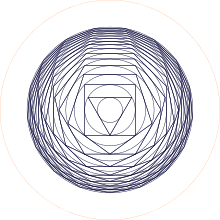
Any regular polygon is cyclic. Consider a unit circle, then circumscribe a regular triangle such that each side touches the circle. Circumscribe a circle, then circumscribe a square. Again circumscribe a circle, then circumscribe a regular 5-gon, and so on. The radii of the circumscribed circles converge to the so-called polygon circumscribing constant
(sequence A051762 in the OEIS). The reciprocal of this constant is the Kepler–Bouwkamp constant.
See also
- Circumgon
- Circumscribed sphere
- Inscribed circle
- Japanese theorem for cyclic polygons
- Japanese theorem for cyclic quadrilaterals
- Jung's theorem, an inequality relating the diameter of a point set to the radius of its minimum bounding sphere
- Kosnita theorem
- Lester's theorem
- Tangential polygon
- Triangle center
Notes
- Whitworth, William Allen. Trilinear Coordinates and Other Methods of Modern Analytical Geometry of Two Dimensions, Forgotten Books, 2012 (orig. Deighton, Bell, and Co., 1866). http://www.forgottenbooks.com/search?q=Trilinear+coordinates&t=books
- Clark Kimberling's Encyclopedia of Triangles "Archived copy". Archived from the original on 2012-04-19. Retrieved 2012-06-02.CS1 maint: archived copy as title (link)
- Wolfram page on barycentric coordinates
- Dörrie, Heinrich, 100 Great Problems of Elementary Mathematics, Dover, 1965.
- Nelson, Roger, "Euler's triangle inequality via proof without words," Mathematics Magazine 81(1), February 2008, 58-61.
- Dragutin Svrtan and Darko Veljan, "Non-Euclidean versions of some classical triangle inequalities", Forum Geometricorum 12 (2012), 197–209. http://forumgeom.fau.edu/FG2012volume12/FG201217index.html
- Marie-Nicole Gras, "Distances between the circumcenter of the extouch triangle and the classical centers", Forum Geometricorum 14 (2014), 51-61. http://forumgeom.fau.edu/FG2014volume14/FG201405index.html
- Smith, Geoff, and Leversha, Gerry, "Euler and triangle geometry", Mathematical Gazette 91, November 2007, 436–452.
- Johnson, Roger A., Advanced Euclidean Geometry, Dover, 2007 (orig. 1929).
- Posamentier, Alfred S., and Lehmann, Ingmar. The Secrets of Triangles, Prometheus Books, 2012.
- Altshiller-Court, Nathan, College Geometry, Dover, 2007.
- De Villiers, Michael. "Equiangular cyclic and equilateral circumscribed polygons," Mathematical Gazette 95, March 2011, 102–107.
- Buchholz, Ralph H.; MacDougall, James A. (2008), "Cyclic polygons with rational sides and area", Journal of Number Theory, 128 (1): 17–48, doi:10.1016/j.jnt.2007.05.005, MR 2382768, archived from the original on 2018-11-12, retrieved 2012-04-11.
- Inequalities proposed in “Crux Mathematicorum”, .
References
- Coxeter, H.S.M. (1969). "Chapter 1". Introduction to geometry. Wiley. pp. 12–13. ISBN 0-471-50458-0.
- Megiddo, N. (1983). "Linear-time algorithms for linear programming in R3 and related problems". SIAM Journal on Computing. 12 (4): 759–776. doi:10.1137/0212052.
- Kimberling, Clark (1998). "Triangle centers and central triangles". Congressus Numerantium. 129: i–xxv, 1–295.
- Pedoe, Dan (1988) [1970]. Geometry: a comprehensive course. Dover. ISBN 0-486-65812-0.
External links
- Derivation of formula for radius of circumcircle of triangle at Mathalino.com
- Semi-regular angle-gons and side-gons: respective generalizations of rectangles and rhombi at Dynamic Geometry Sketches, interactive dynamic geometry sketch.
MathWorld
Interactive
- Triangle circumcircle and circumcenter With interactive animation
- An interactive Java applet for the circumcenter
